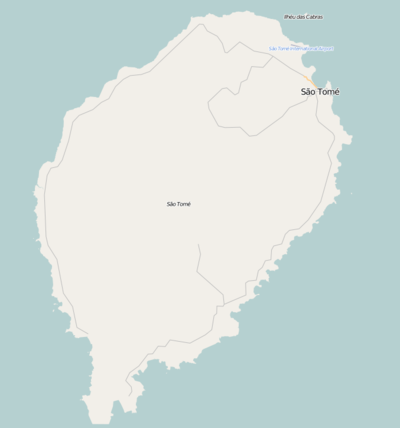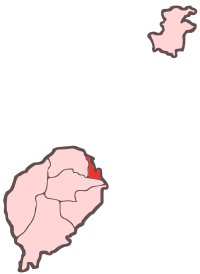Patrice Lumumba Preparatory School
| Patrice Lumumba Preparatory School Escola Preparatória Patrice Lumumba | |
|---|---|
| Address | |
 Patrice Lumumba Preparatory School | |
|
Avenida Kwama N'Krume São Tomé, São Tomé Island São Tomé and Príncipe | |
| Coordinates | 0°20′09″N 6°43′51″E / 0.3359°N 6.7309°E |
| Information | |
| Established | 21 September 1952 |
| Director | Fernando Varela[1] |
| Number of students | c. 3,000 (2015)[2] |
Patrice Lumumba Preparatory School (Portuguese: Escola Preparatória Patrice Lumumba, abbreviation: EPLP) is a lyceum located at Avenida Marginal 12 Julho in the subdivision of Ponta Mina, city of São Tomé, São Tomé and Príncipe. The institution is the oldest in the country, it is also one of the oldest in the Guif of Guinea Islands and the westernmost portion of the equatorial part of Central Africa. It currently has an estimate of 3,000 students.[3] It is also a building of Heritage of Portuguese Influence.[4]
Nearby features
The prep school are surrounded by Água Grande, one of the longest rivers in the nation, EN1, the route bordered as its starting point intersecting the EN2, the route links with the south of the island especially Porto Alegre, that section is a street, Rua de Barão de Água Grande, named after its nearby stream and to the north is Avenida Kwama N'Krume (or N'Kruma). Northeast of the school, a street also named for Patrice Lumumba.
Surrounding buildings and landmarks is the Santomean Ministry of Health headquarters to the north, a Polyclinic Center to the northeast opposite to the stream as well as the Power and Water Company. Northwest is the Seventh-Day Adventist church.
History
The school was the first secondary level school opened in the archipelago as well as the Gulf of Guinea Islands outside Bioko, today part of Equatorial Guinea. It gained a new purpose after independence.
EPPL originated from the São Tomé College-Lyceum, which was created under a provincial ordinance no. 1947 of 21 September 1952, an initiative by the colonial governor Guilherme Abranches Pinto. The College Building, seat of a new institution began construction in 1952, with an architectural project by Lucínio Cruz, it was finished in 1954.[5]
Through the decree-law no. 45512 of 18 September 1959, the Ministry of Overseas made the College-Lyceum being renamed to Liceu Nacional D. João II (John II National Lyceum), after John II of Portugal, and was equipped by a juridical regime of lyceums from the Portuguese Main.[6]
After independence
After independence on 12 July 1975, the school was renamed to Escola D. Pedro I (Dom Pedro I School), named after the first of two emperors of Brazi, at the time, a strong Brazilian influence with the training of its teachers into the new country. From then, the school in part offered the preparatory cycle, transferred the lyceum's assignments to Escola Técnica Silva e Cunha (now the National Lyceum).[7]
In 1988, in the midst of reforms of Santomean education, the institution changed its name to Patrice Lumumba Preparatory School ( Escola Preparatória Patrice Lumumba), after Patrice Lumumba, one of the greatest Pan-African idealists in history.[8]
In mid-2012, the school faced a wave of psychic trance that affected some students, with cases of children outside themselves including violent and rolling on the ground, leaving the archipelago's population very scared.[9] In 2015, EPPL closed its doors for some times, due to an allergy outbreak that affected several students in the institution, forcing them to be hospitalized at Hospital Ayres de Menezes.[10]
Architecture
Its seat, the College Building, a part of the national architectural heritage.[4]
See also
References
- ↑ "NUSTP dá Boas Entradas ao Estudante Bruno Semedo" (in Portuguese). A Voz de São Tomé e Príncipe (Voice of São Tomé e Príncipe). 26 January 2017.
- ↑ "Alunas da escola Patrice Lumumba afetadas por surto de alergia" (in Portuguese). Virtina ST. 19 March 2015.
- ↑ Castro, Adilson (27 September 2016). "Arranca novo Ano Lectivo 2016-2017 em São Tomé e Príncipe". Diário de São Tomé e Príncipe - Jornal Transparência. Retrieved 2012-12-20.
- 1 2 Milheiro, Ana Vaz (2008). "Liceu Nacional Patrice Lumumba (former Colégio-Liceu de S. Tomé / Liceu Nacional D. João II)". Heritage of Portuguese Influence/ Património de Influência Portuguesa — HPIP. Retrieved 2018-01-10.
- ↑ MIlheiro, Ana Vaz (2012). São Tomé e Príncipe e o trabalho do Gabinete de Urbanização Colonial (1944-1974) [São Tomé and Príncipe And Work of the Colonial Urbanisation Cabinet (1944-1974)] (PDF). Lisbon: University Institute of Lisbon, Central of African Studies: Actas do Colóquio Internacional São Tomé e Príncipe numa perspectiva interdisciplinar, diacrónica e sincrónica. p. 87-127. ISBN 978-989-732-089-7.
- ↑ Decree-Law no. 42512 (in Portuguese). 1. Portuguese Ministry of Overseas - Director-General. 18 September 1959.
- ↑ "New Lyceum Opened by Fradique de Menezes". Tela Non (in Portuguese). 30 August 2011.
- ↑ Sousa, oão da Silva Pinto de. "Abordagem Histórica do Sistema Educacional de São Tomé e Príncipe Pós - Colonial (1975 – 1990)". Missing or empty
|url=(help) - ↑ "Onda de transe encerra escola preparatória Patrice Lumumba". Téla Nón (in Portuguese). 7 June 2012.
- ↑ "Surto de alergia afasta dezenas de alunos da escola Patrice Lumumba". Jornal Tropical de São Tomé (in Portuguese). 25 March 2015.
